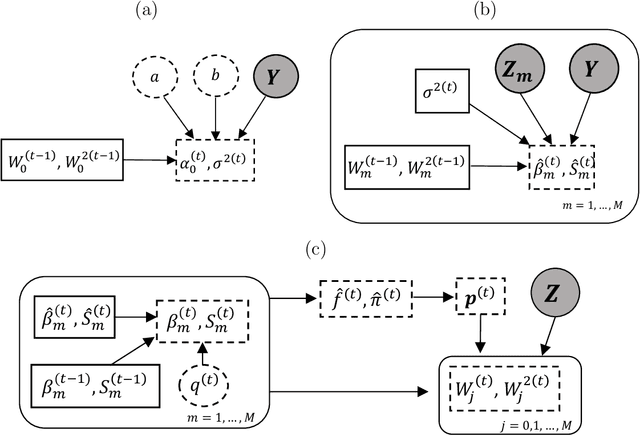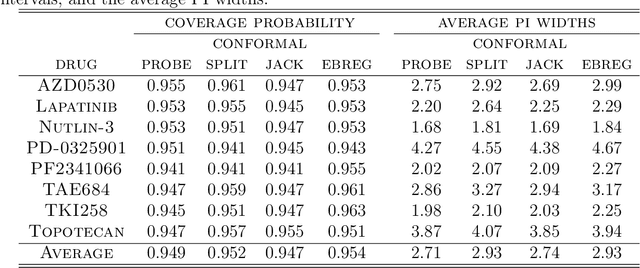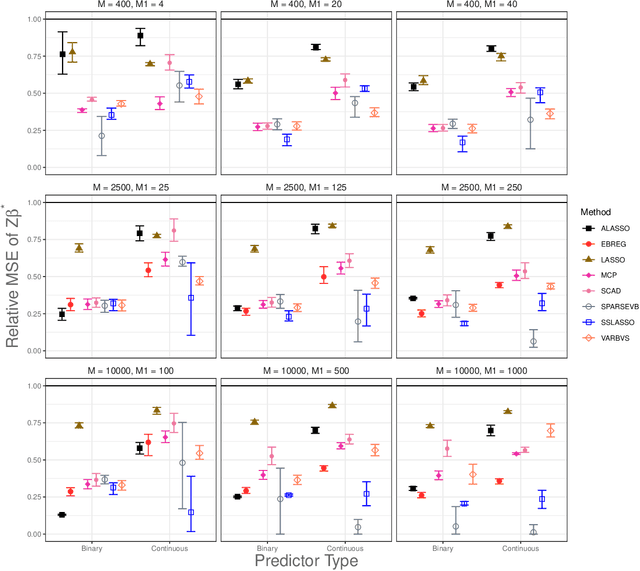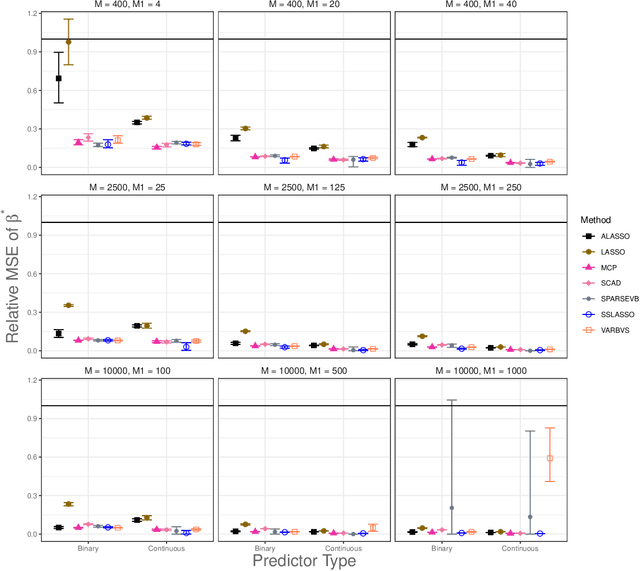Anja Zgodic
Sparse high-dimensional linear mixed modeling with a partitioned empirical Bayes ECM algorithm
Oct 18, 2023Abstract:High-dimensional longitudinal data is increasingly used in a wide range of scientific studies. However, there are few statistical methods for high-dimensional linear mixed models (LMMs), as most Bayesian variable selection or penalization methods are designed for independent observations. Additionally, the few available software packages for high-dimensional LMMs suffer from scalability issues. This work presents an efficient and accurate Bayesian framework for high-dimensional LMMs. We use empirical Bayes estimators of hyperparameters for increased flexibility and an Expectation-Conditional-Minimization (ECM) algorithm for computationally efficient maximum a posteriori probability (MAP) estimation of parameters. The novelty of the approach lies in its partitioning and parameter expansion as well as its fast and scalable computation. We illustrate Linear Mixed Modeling with PaRtitiOned empirical Bayes ECM (LMM-PROBE) in simulation studies evaluating fixed and random effects estimation along with computation time. A real-world example is provided using data from a study of lupus in children, where we identify genes and clinical factors associated with a new lupus biomarker and predict the biomarker over time.
Heteroscedastic sparse high-dimensional linear regression with a partitioned empirical Bayes ECM algorithm
Oct 03, 2023Abstract:Sparse linear regression methods for high-dimensional data often assume that residuals have constant variance. When this assumption is violated, it can lead to bias in estimated coefficients, prediction intervals (PI) with improper length, and increased type I errors. We propose a heteroscedastic high-dimensional linear regression model through a partitioned empirical Bayes Expectation Conditional Maximization (H-PROBE) algorithm. H-PROBE is a computationally efficient maximum a posteriori estimation approach based on a Parameter-Expanded Expectation-Conditional-Maximization algorithm. It requires minimal prior assumptions on the regression parameters through plug-in empirical Bayes estimates of hyperparameters. The variance model uses a multivariate log-Gamma prior on coefficients that can incorporate covariates hypothesized to impact heterogeneity. The motivation of our approach is a study relating Aphasia Quotient (AQ) to high-resolution T2 neuroimages of brain damage in stroke patients. AQ is a vital measure of language impairment and informs treatment decisions, but it is challenging to measure and subject to heteroscedastic errors. It is, therefore, of clinical importance -- and the goal of this paper -- to use high-dimensional neuroimages to predict and provide PIs for AQ that accurately reflect the heterogeneity in residual variance. Our analysis demonstrates that H-PROBE can use markers of heterogeneity to provide narrower PI widths than standard methods without sacrificing coverage. Through extensive simulation studies, we exhibit that H-PROBE results in superior prediction, variable selection, and predictive inference than competing methods.
Sparse high-dimensional linear regression with a partitioned empirical Bayes ECM algorithm
Sep 20, 2022



Abstract:Bayesian variable selection methods are powerful techniques for fitting and inferring on sparse high-dimensional linear regression models. However, many are computationally intensive or require restrictive prior distributions on model parameters. Likelihood based penalization methods are more computationally friendly, but resource intensive refitting techniques are needed for inference. In this paper, we proposed an efficient and powerful Bayesian approach for sparse high-dimensional linear regression. Minimal prior assumptions on the parameters are required through the use of plug-in empirical Bayes estimates of hyperparameters. Efficient maximum a posteriori probability (MAP) estimation is completed through the use of a partitioned and extended expectation conditional maximization (ECM) algorithm. The result is a PaRtitiOned empirical Bayes Ecm (PROBE) algorithm applied to sparse high-dimensional linear regression. We propose methods to estimate credible and prediction intervals for predictions of future values. We compare the empirical properties of predictions and our predictive inference to comparable approaches with numerous simulation studies and an analysis of cancer cell lines drug response study. The proposed approach is implemented in the R package probe.
 Add to Chrome
Add to Chrome Add to Firefox
Add to Firefox Add to Edge
Add to Edge